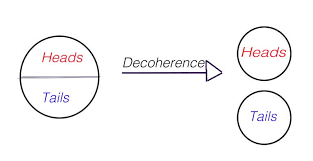How did Decoherence comes up?
Quantum Decoherence is the loss of quantum coherence between the components of a quantum system that occurs due to interactions with the environment. Quantum systems exist in coherent superpositions of multiple states or configurations. Decoherence causes this quantum coherence to decrease over time as the system interacts and entangles with the environment.
Quantum mechanics was originally developed to describe the properties of microscopic systems. However, the formulation of quantum mechanics was such that it considered all degrees of freedom for a microscopic or macroscopic system. It was on this basis that not observing quantum properties at the macroscopic level became one of the unsolvable problems from the point of view of quantum mechanics; As far as the issue of converting the quantum world to the classical one was viewed as a philosophical issue rather than a physical one. In Copenhagen’s understanding Copenhagen’s understanding of quantum, the classical and quantum systems are considered two separate systems, and talk about the boundary between the two is cleverly bypassed.
Using the measurement principle of quantum mechanics, Copenhagen saw the transformation of the quantum world into a classical one as a black box that neither informed how the system was measured nor how the quantum behavior disappeared on the macroscopic scale. This problem is well evident in the paradox of Schrödinger’s cat. This hypothetical experiment considers a cat (macroscopic system) that has two states, alive and dead. The cat system is interacted with a radioactive atom, and after some time the state function of the cat system, due to the interaction with the atom, becomes a superposition of the alive and dead states.
Why the juxtaposition of the two dead and alive states of a cat cannot be observed on a macroscopic scale was a problem that was not solved until the late 1980s; When Mr. Zorek showed by using the decoherence theory that Schrödinger’s cat has two states, alive and dead, only probabilistically and not quantumly. With this theory, he showed that the reduced density matrix of a system, which interacts with a large number of degrees of freedom of its surroundings, becomes diagonal after a very short period of coherence time. The diagonality of the reduced density matrix of a system indicates its classicality. With an example, we explain the difference between a two-state system that behaves quantumly and behaves classically by showing its reduced density matrix.
Decoherence example
The reduced density matrix of a two-scale atom in the state
![]()
The state of the atom is in two levels and still maintains its coherence, it is as follows:

But the reduced density matrix of a symmetric coin, which behaves classically, is the following, which is a diagonal matrix:

Since when was quantum Decoherence noticed?
Since at the time when the Decoherence theory was proposed, there was no need to observe quantum properties on a macroscopic scale, so this theory was not given much value; Until the need to build a quantum computer and maintain quantum coherence for a certain period of time to perform quantum calculations made it a very important issue to investigate the factors that cause Decoherence on quantum systems and how to reduce it.
Some key points about quantum Decoherence
- Quantum decoherence explains why we tend to see definite states rather than superpositions at the macroscopic level. Interactions quickly destroy coherence between superimposed states.
- Decoherence induces a clear decay of the wave function and a probabilistic mixture of states consistent with classical physics. Coherent superpositions become incoherent mixtures of states.
- Decoherence occurs due to the entanglement between the system and the environment. The creation of quantum entanglement disrupts the coherent phase relations in the superposition.
- The process can be seen as a transfer of information about the state of the system to the environment. This information becomes inaccessible and coherence is lost.
- The rate of non-uniformity depends on the strength of the interaction between the system and the environment. Stronger coupling to the medium leads to faster misalignment.
- Quantum coherence and superpositions can be maintained by isolating the system from the environment. This is a key challenge in quantum computing.



